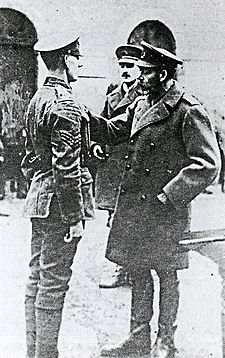Arthur Evans (VC) facts for kids
Quick facts for kids
Arthur Walter Evans
|
|
|---|---|

Arthur Evans being awarded the VC by George V
|
|
| Born | 8 April 1891 Liverpool, England |
| Died | 1 November 1936 (aged 45) Sydney, Australia |
| Allegiance | |
| Service/ |
|
| Rank | Sergeant |
| Unit |
|
| Battles/wars | First World War |
| Awards | Victoria Cross Distinguished Conduct Medal |
Arthur Walter Evans (born April 8, 1891 – died November 1, 1936) was a very brave English soldier. He received the Victoria Cross (VC), which is the highest award for bravery a soldier can get. This special medal is given to members of the British and Commonwealth forces for incredible courage when facing the enemy. He was also known by the name "Walter Simpson" when he joined the army.
A Brave Act: Earning the Victoria Cross
Arthur Evans was 27 years old during the First World War. He was a lance sergeant in the 6th Battalion of The Lincolnshire Regiment, part of the British Army. He earned his Victoria Cross for an amazing act of bravery. He had joined the army using the name Walter Simpson, and that's the name under which he received his medal.
On September 2, 1918, near a place called Etaing in France, Sergeant Evans was on patrol. His group saw an enemy machine-gun on the other side of a deep river. Sergeant Evans bravely volunteered to swim across the river by himself.
After swimming across, he quietly crawled up behind the enemy machine-gun post. He managed to shoot two enemy soldiers and made four others surrender. This was a very dangerous and courageous act.
Soon after, a safe way to cross the river was found. An officer and another soldier joined Sergeant Evans. However, the enemy then started firing heavily at them with machine guns and rifles. The officer was wounded during this attack. Sergeant Evans, showing great courage, covered the officer's retreat. He made sure the wounded officer could get back safely, all while under very heavy enemy fire.
Life After the War
After the First World War ended, Arthur Evans moved to Australia. There, he continued his military service. He joined the Australian Tank Corps, which was a part of the Australian Army. He served there until his death in 1936.

